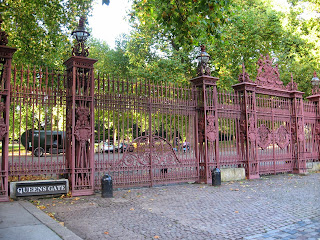Have you ever wondered what the inside of a regular aristocratic home looks like? Once upon a time the aristocracy was definitely closer to royalty than to middle class people. But, because of collections I am about to tell you about, most of the surviving members of those families are BROKE! Status in this country is more about power and to whom you are related. In fact, those of the aristocracy (and those in the lower classes) hate the middle class's obsession with Brand Names. It seems backwards ... believe me, I'm just as confused by social classes here .... it is indeed backwards, and I don't pretend to understand how it all works.
If you can't figure out the previous paragraph, don't worry about it. Just look ahead to one of the most amazing private collections in Britain: The Wallace Collection at the Hertford House. Why not the Wallace House? Well, Sir Richard Wallace inherited the collection from his father, Sir Richard Seymour-Conway, 4th Marquess of Hertford. Wallace was a bastard child, but the only one of Conway, and had practically zero contribution to the collection. After Wallace's death, his widow donated the collection and the house to the public, on the condition that no item in the collection is ever removed (not even to go on loan).
 |
| Main Staircase across from front doors |
A few fun facts about the collection: it is the largest private collection of clocks (see how many you can spot in the pictures below) and of armor! The brochure didn't mention anything about this, but every room had at least one bronze sculpture of Hercules slaying some monster (I really liked finding these!). There were lots of paintings, including some Rubens, Canaletto (he painted all those scenes of Venice), Rembrandt (even a self portrait), Turner, Joshua Reynolds (who I really love), van Dyck, and more.
 |
| Green Room |
The house itself is very beautiful. While the house is large, the rooms are not - there are just a lot of rooms. I've noticed this in and around London, even in places like Buckingham and Windsor. In the US it's definitely more fashionable to have a big house with big rooms. Every room in Hertford was a different color, and vibrantly decorated.
The Green Room (these rooms had actual names, but my memory isn't that good) was one of my favorites mostly because green is my favorite color (in case you are ever overwhelmed with the urge to buy me things). Ironically, I don't think this room had a Hercules sculpture, but it did have an excellent ship painting on the wall opposite an exquisite mantel clock! This room had 6 clocks.
 |
| Green Room Fireplace and Mirror |
Also, do you see the long, glass-doored book shelf under the ships? Well, the middle shelf contains the complete Encyclopedia Britannica (circa 1800), and the lower shelf has all the supplements! Thank goodness for digital archives!
(I apologize if the pictures aren't so clear. The lighting in some of the rooms was dimmer in order to preserve the artwork on the walls.)
All the items in the Wallace collection were purchased on one of Conway's many trips around the world, which is why there is such an incredible variety. (Collections like this is probably why the aristocracy has no more money. In fact, on the eve of the First World War, it was fashionable to marry American socialites because even though their money was "dirty" money (money earned instead of inherited), it could still be used to "bail out" the British aristocracy). The widest variation, however, is most apparent in the EXTENSIVE collection of weapons and armor. In fact, there is a whole wing of the house called "The Armory". It has suits of amour (many of them complete suits) from all over the world, from almost every century! There are also full-body equine armor sets! Can you believe that? It was really cool to see. Weapons included swords, pistols, bayonettes, daggers, lances, those spikey balls on the end of a chain (heck if I know what that's called), throwing stars .... the list is never-ending!
These were the two complete equine war suits in the collection.
 |
| Red Room |
And, no Victorian aristocratic home would be complete without a painting of Her Royal Highness, Queen Victoria .... in the Royal Red Room, no less!
If you cannot spot her, a young depiction of Victoria is on the right side of this picture. Just below her frame are 3 Herculean sculptures!
I hope you enjoyed your peek into this aristocratic home, and thanks for reading.

















































